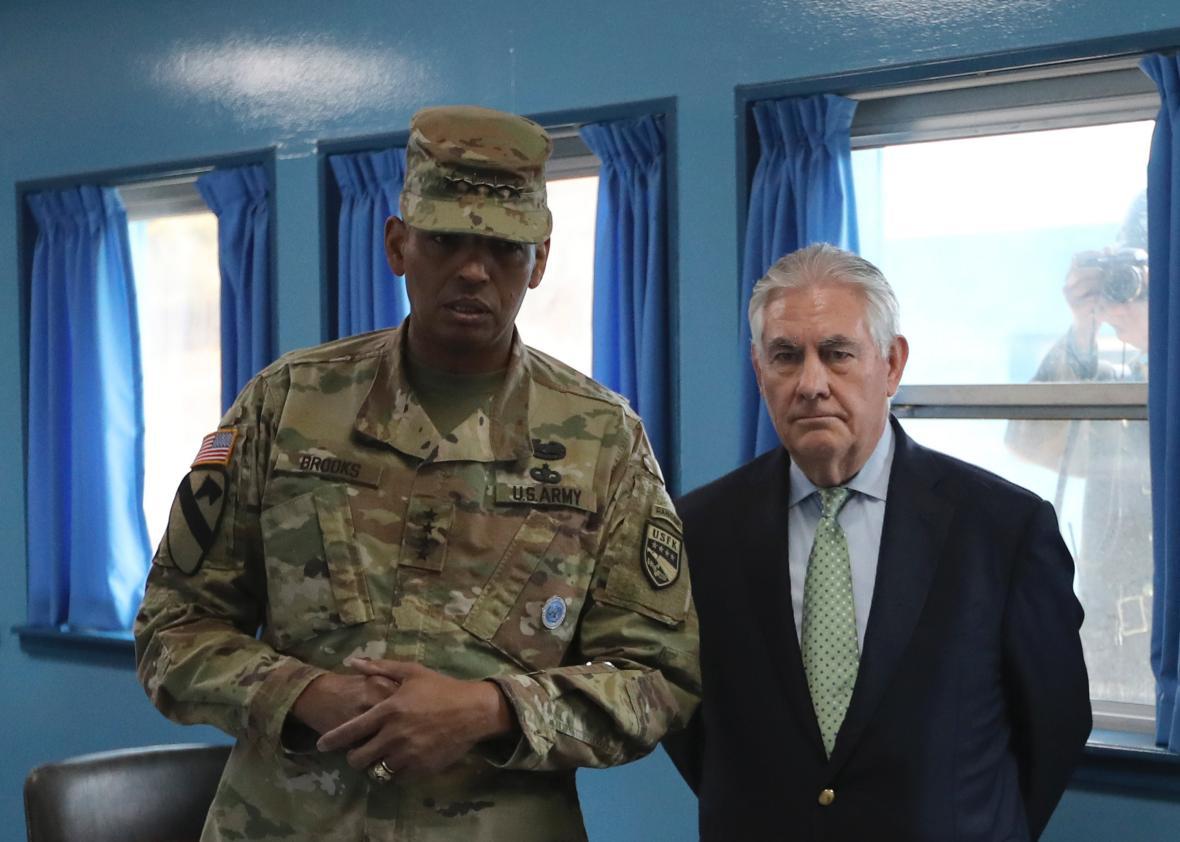Rex Tillerson has reportedly cut short his meetings with South Korean leaders during a visit to Seoul, with local officials citing the secretary of state’s “fatigue,” but not before making a bit of news: Thursday Tillerson declared decades of attempted diplomatic engagement with North Korea a failure and warned that “all options are on the table” to deter the nuclear threat from the country.
The implicit threat of military force is what’s making headlines and push notifications Friday, but Tillerson’s tough talk is not so extraordinary. President Obama also warned North Korea that the United States “will not hesitate to use our military might” to defend its allies. When Tillerson says, “I think it’s important to recognize that the political and diplomatic efforts of the past 20 years to bring North Korea to the point of denuclearization have failed,” he’s not wrong—nor is he saying anything new. Obama also came into office promising a new approach that would break the pattern of carrot-and-stick diplomacy that had failed to deter North Korea’s nuclear ambitions. So did George W. Bush for that matter.
The Trump administration’s options for actually implementing a new approach are limited, in part because the countries involved are anything but unified. The U.S. is currently installing a THAAD missile defense system in South Korea, to bolster that country’s defenses. But the South Korean political situation is in flux right now, following the recent impeachment of President Park Geun-hye. The likely candidates to replace Park in upcoming elections all favor a more conciliatory approach to North Korea and have expressed skepticism about THAAD. This would put South Korea at odds with both the United States and Japan, which is stretching the limits of its pacifist constitution, with lawmakers arguing for a buildup of offensive weapons to counter the North Korea threat. Japan and South Korea are also currently locked in a bitter diplomatic dispute over a statue of a Korean “comfort woman” placed outside the Japanese consulate in Busan, which prompted Tokyo to withdraw two of its diplomats.
China, where Tillerson is heading next, assuming he’s up to it, is strongly opposed to the U.S. installing the THAAD system in South Korea, viewing it as a thinly veiled American attempt to monitor China’s own missile capabilities. It has responded to the installation by punishing South Korean businesses and restricting travel to the country. The Chinese reaction to THAAD being installed in Japan—another idea that’s been put forward—would be even stronger. China is certainly frustrated with its problematic neighbor and recently suspended coal imports from North Korea, a crucial revenue stream for the isolated regime, but it’s not clear how stringently that ban is being enforced and the United States would like China to apply even more pressure. But there’s only so far China will go. It doesn’t actually want the North Korean regime to collapse, leaving a chaotic impoverished population in need of assistance on its doorstep. And it views U.S. and Japanese militarism in the region as equally or more threatening than Kim Jong-un’s nuclear adventurism.
So how scary are things? While it’s not clear that Tillerson’s threats of military action are any more serious than the tough talk of previous administrations, the prospect of an attack on North Korea is deeply alarming, in large part because, as Jeffery Lewis recently wrote, there’s every indication that North Korea intends to use its nuclear weapons early, to repel such an invasion. Kim does not want to share the fate of Saddam Hussein or Muammar Qaddafi, and if he believes an attack is imminent, the likelihood that he will attack first goes up. So if the U.S. backs up Trump and Tillerson’s boilerplate bluster with a military posture that’s actually more aggressive, that might encourage rather than deter a disaster.
North Korea’s nuclear capabilities are also improving at an alarming clip. The country appears to be taking the final steps to arm its missiles with nuclear weapons, and earlier this month fired four missiles in what it said was a drill to practice an attack on U.S. military bases in Japan. It’s still years away from developing intercontinental ballistic missiles capable of reaching the United States, but it appears to be making progress toward that goal. President Trump has vowed that this “won’t happen.” But so far, it’s not clear how he plans to prevent it.
